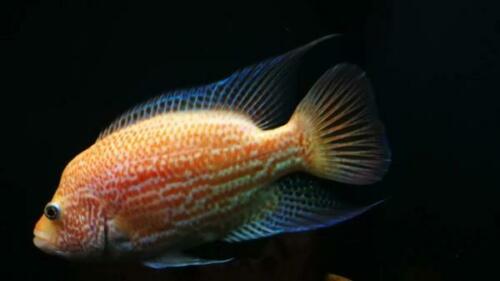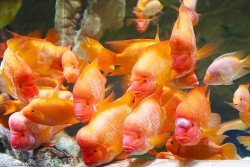Red Dovii Cichlid for Sale (Parachromis dovii)
 Red Dovii cichlid appears to be a xanthic mutation that displays reduced pigment, a base yellow or gold coloration, and iridescent red or orange spotting.
Red Dovii cichlid appears to be a xanthic mutation that displays reduced pigment, a base yellow or gold coloration, and iridescent red or orange spotting.The Red Morph Parachromis dovii: A Striking Variant of the Wolf Cichlid
The Red Morph Parachromis dovii, scientifically known as Parachromis dovii, is a captivating and sought-after variant of the Wolf Cichlid. This remarkable fish, originating from Central America, has gained popularity among aquarium enthusiasts for its striking coloration, robust size, and intriguing behavior. In this comprehensive overview, we delve into the unique characteristics, care requirements, and the allure of the Red Morph Parachromis dovii.

1. Distinctive Appearance:
The Red Morph Parachromis dovii is celebrated for its extraordinary and vibrant coloration. Unlike the typical gray or silverish hues of the species, this variant exhibits a rich and eye-catching red coloration on its body and fins, giving it a fiery and captivating presence in the aquarium. The intensity of the red color can vary, with some individuals showcasing deeper shades while others may have a more subtle reddish tint. This striking appearance sets the Red Morph apart from its counterparts.
2. Size and Growth Potential:
Similar to the wild-type Wolf Cichlid, the Red Morph Parachromis dovii can attain a substantial size. Males can grow to be around 28 inches (70 cm) or even larger, while females tend to be slightly smaller. As they grow, their vibrant red coloration becomes more pronounced, making them even more breathtaking to behold.
3. Native Habitat and Behavior:
In their natural habitat of Central America, Red Morph Parachromis dovii primarily inhabit slow-moving rivers, streams, and lagoons. They are known for their aggressive and territorial behavior, especially during the breeding season. When kept in an aquarium, it's essential to provide adequate hiding spots and a spacious environment to manage their territorial tendencies.
4. Tank Setup and Water Parameters:
Creating the right tank environment is crucial for the well-being of Red Morph Parachromis dovii. They require a spacious aquarium with a minimum size of 150 gallons or more to accommodate their size and territorial nature. Provide hiding spots, rocks, driftwood, and ample swimming space. Maintain water conditions with a stable temperature range of 76-82°F (24-28°C), a pH level between 7.5 and 8.5, and moderate water hardness.
5. Feeding Habits:
Red Morph Parachromis dovii are carnivorous and have a voracious appetite. In their natural habitat, they primarily feed on smaller fish, insects, crustaceans, and other aquatic prey. In captivity, offer a diet consisting of high-quality pellets, live or frozen foods like fish, shrimp, and other protein-rich options. Providing a varied diet will help ensure their optimal health and coloration.
6. Breeding the Red Morph:
Breeding Red Morph Parachromis dovii can be a challenging yet rewarding endeavor. They are known for their strong parental instincts. To encourage breeding, provide a separate breeding tank with caves or suitable spawning sites. The female will lay eggs, and both parents will guard and care for the fry, showcasing remarkable parenting behaviors.
7. Suitability for Experienced Aquarists:
Due to their territorial nature, size, and specific care requirements, Red Morph Parachromis dovii are better suited for experienced aquarists who can provide the necessary accommodations and manage their potentially aggressive behavior. Proper tank maintenance, regular monitoring, and a commitment to their well-being are essential.
In conclusion, the Red Morph Parachromis dovii stands as a testament to the mesmerizing diversity within the world of aquarium fish. Its vivid red coloration, impressive size, and intriguing behavior make it a coveted addition to the tanks of experienced aquarists looking for a captivating and rewarding challenge in the realm of cichlid keeping.
The Red form of the Costa Rican Red dovii cichlid Parachromis dovii
References
Parachromis dovii - WikipediaThe Guapote Parachromis dovii


